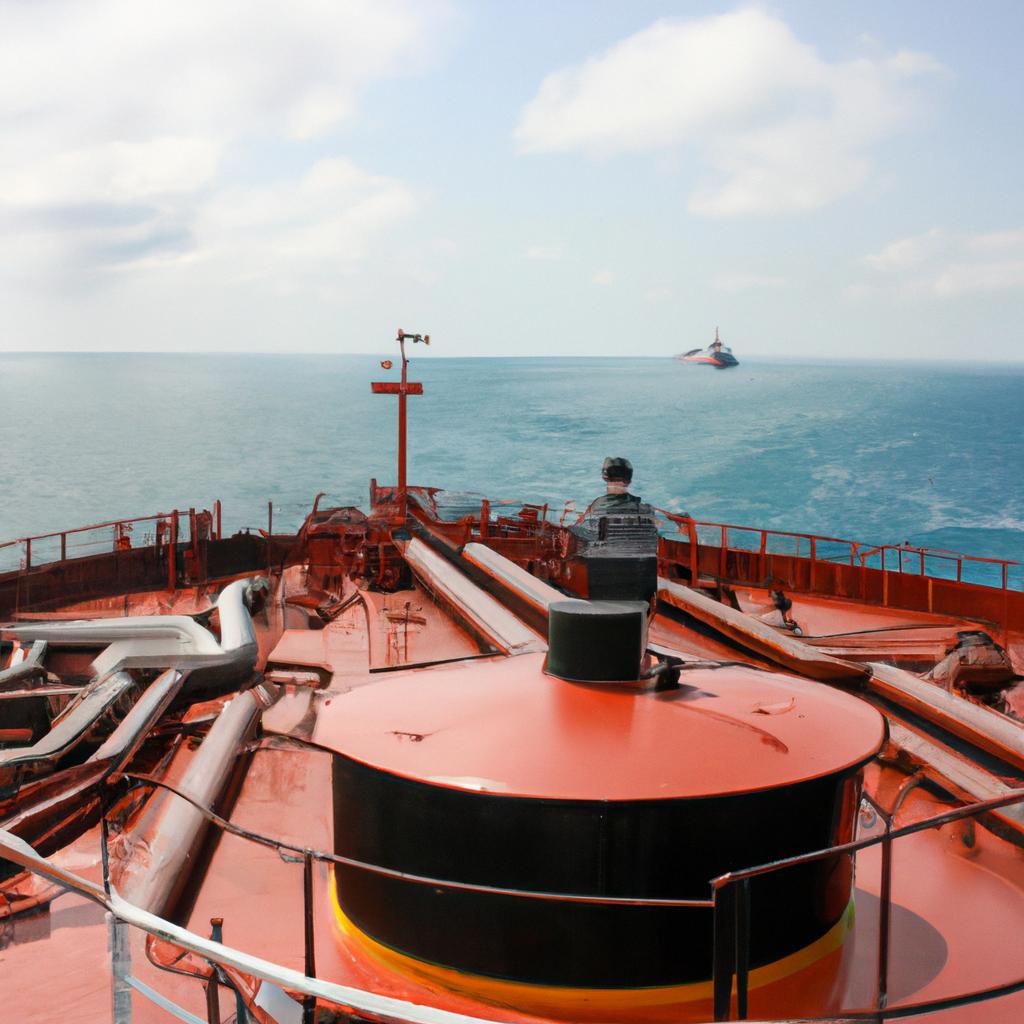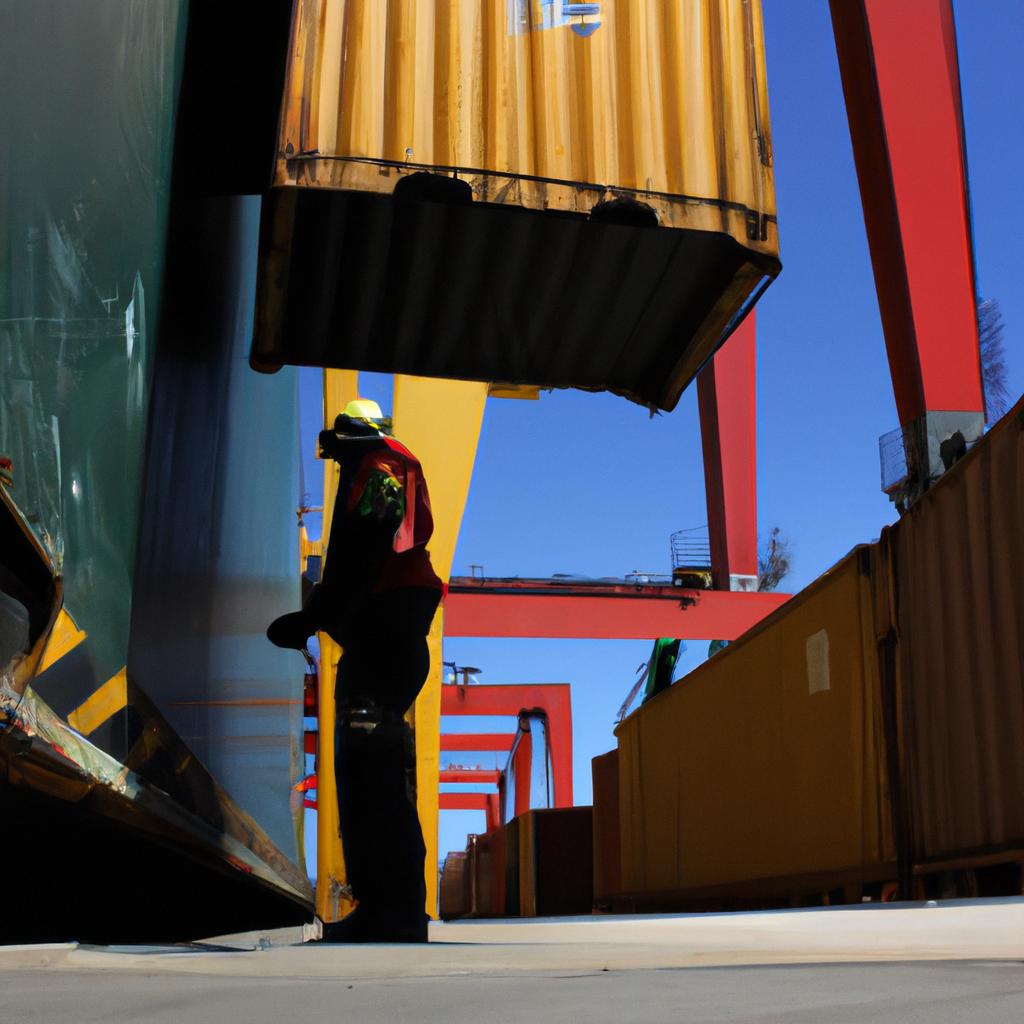The efficient transportation of goods is critical for enhancing trade and economic growth in the Black Sea region. However, the complexities associated with route optimization pose significant challenges to freight shipping companies operating in this area. This article aims to explore the importance of route optimization for black sea transport and its potential to boost freight rates.
To illustrate the significance of route optimization, let us consider a hypothetical scenario where Company X operates a fleet of cargo vessels transporting various goods across the Black Sea region. Without effective route planning, Company X may encounter several obstacles such as longer travel times, increased fuel consumption, and higher operational costs. By implementing an optimized routing strategy, which takes into account factors like distance, weather conditions, port congestion, and vessel capacity utilization, Company X can streamline its operations and achieve cost savings while improving overall efficiency.
In order to understand the benefits of route optimization more comprehensively, it is essential to analyze how it influences freight rates. The optimization process enables shipping companies to identify shorter routes or alternative ports that minimize transit time and reduce unnecessary delays. Consequently, improved efficiency leads to quicker delivery times and lower inventory holding costs for customers. Additionally, by optimizing routes based on market demand patterns and identifying profitable trade lanes, shipping companies can also capitalize on competitive pricing strategies that attract attract more customers and increase their market share. By offering competitive freight rates, shipping companies can attract more business and generate higher revenue.
Furthermore, route optimization also plays a crucial role in reducing fuel consumption and emissions, which is an important consideration in today’s environmentally conscious world. By finding the most efficient routes, shipping companies can minimize the distance traveled and optimize vessel speed to reduce fuel usage. This not only results in cost savings but also helps in reducing carbon footprint and promoting sustainability.
In conclusion, route optimization is of utmost importance for freight shipping companies operating in the Black Sea region. It enables them to streamline operations, achieve cost savings, improve efficiency, and ultimately boost freight rates. By utilizing advanced technologies and data analysis techniques, shipping companies can identify the most optimal routes that consider various factors such as distance, weather conditions, port congestion, and vessel capacity utilization. Implementing route optimization strategies not only benefits the shipping industry but also contributes to trade facilitation and economic growth in the Black Sea region.
Current Challenges in Black Sea Transport
One example of the challenges faced in Black Sea transport is the issue of inefficient route planning. For instance, consider a shipping company that transports goods from Ukraine to Turkey. Due to limited information on optimal routes and lack of real-time data on weather conditions, this company often ends up taking longer routes, resulting in increased fuel consumption and higher transportation costs.
To illustrate the impact of inefficiencies in Black Sea transport, let us explore some key issues:
- Delays: Inadequate route planning leads to delays in cargo delivery, affecting both suppliers and buyers. This can result in financial losses for businesses relying on timely shipments.
- Environmental Impact: Longer routes not only increase fuel consumption but also contribute to higher carbon emissions. The environmental implications are significant considering the volume of maritime traffic in the region.
- Safety Risks: Suboptimal routes may expose vessels to hazardous sea conditions such as rough waters or storms, increasing the risk of accidents or damage to cargo.
- Economic Losses: Inefficient transportation practices hinder economic growth by raising freight rates and reducing competitiveness within global markets.
Table 1 provides an overview of these challenges related to Black Sea transport:
| Challenge | Description |
|---|---|
| Delays | Inadequate route planning leads to shipment delays |
| Environmental Impact | Longer routes increase fuel consumption and carbon emissions |
| Safety Risks | Suboptimal routes expose vessels to hazardous sea conditions |
| Economic Losses | Inefficient transportation practices raise freight rates and reduce market competitiveness |
Despite these challenges, it is crucial for stakeholders involved in Black Sea transport to address them proactively. By improving route optimization strategies, companies can mitigate delays, reduce their environmental footprint, enhance safety measures, and ultimately boost economic growth.
Transitioning into the subsequent section about the importance of route optimization will highlight how addressing these challenges through efficient routing solutions can yield significant benefits for the Black Sea transport industry.
Importance of Route Optimization
To address the current challenges faced by Black Sea transport, it is crucial to focus on route optimization. By strategically planning and optimizing shipping routes, freight rates can be boosted while minimizing costs and ensuring timely deliveries. This section will discuss the importance of route optimization in the context of Black Sea transport.
Example:
Consider a scenario where a shipping company operates between various ports along the Black Sea coast. Currently, their vessels follow traditional routes that are not optimized for efficiency. As a result, they encounter delays due to congested waterways and inefficient navigation patterns. These inefficiencies lead to increased fuel consumption, higher operating costs, and longer transit times. However, through route optimization techniques, this company has the potential to enhance its operations significantly.
Importance of Route Optimization:
-
Minimizing Fuel Consumption: Optimized routes enable ships to navigate through shorter distances and avoid areas prone to congestion or adverse weather conditions. By reducing unnecessary detours and improving vessel speed management, significant savings in fuel consumption can be achieved.
-
Enhancing Cost Efficiency: Efficient routing helps reduce operational expenses associated with maintenance, crew wages, insurance premiums, and other overheads. Additionally, optimized routes allow for better utilization of resources such as port facilities and infrastructure investments.
-
Improving Environmental Sustainability: By minimizing fuel consumption and emissions through optimized routes, maritime transportation can contribute towards environmental sustainability goals set by international regulations like MARPOL (the International Convention for the Prevention of Pollution from Ships).
-
Ensuring Timely Deliveries: Delays caused by suboptimal routes directly impact customer satisfaction and contractual obligations within supply chains. Effective route optimization ensures that shipments reach their destinations promptly, enhancing reliability and trust among stakeholders.
Table – Impact of Route Optimization:
| Benefits | Description |
|---|---|
| Cost Savings | Reduced operational expenses due to improved fuel efficiency |
| Time Efficiency | Shorter transit times resulting in faster deliveries |
| Environmental Sustainability | Lower fuel consumption and emissions, aligning with environmental regulations |
| Customer Satisfaction | Timely and reliable service leading to increased customer satisfaction |
Route optimization plays a critical role in addressing the challenges faced by Black Sea transport. By minimizing fuel consumption, enhancing cost efficiency, improving environmental sustainability, and ensuring timely deliveries, optimized routes can boost freight rates while benefiting all stakeholders involved. In the subsequent section, we will explore the specific benefits that efficient transport routes bring to Black Sea trade.
Benefits of Efficient Transport Routes
Having established the importance of route optimization in maximizing efficiency and reducing costs in maritime transportation, we now turn our attention to the significant benefits that efficient transport routes can bring. To illustrate the impact of effective route planning, let us consider a hypothetical case study involving two shipping companies operating between Istanbul and Odessa.
Effective route optimization offers numerous advantages for maritime transport operators. By carefully analyzing and selecting optimal paths for cargo vessels, these companies can achieve higher freight rates while simultaneously enhancing their overall operational performance. The following points highlight some key benefits derived from efficient transport routes:
-
Reduced Fuel Consumption:
- Avoiding longer distances and unfavorable weather conditions enables ships to optimize fuel consumption.
- This leads to substantial cost savings and contributes to environmental sustainability by minimizing carbon emissions.
-
Improved Transit Times:
- Identifying shorter and more direct routes decreases transit times significantly.
- Faster deliveries enhance customer satisfaction, improve competitiveness, and increase potential revenues.
-
Enhanced Safety:
- Selecting safer navigation corridors reduces risks associated with adverse weather patterns or dangerous areas on sea routes.
- Ensuring safe passages not only protects valuable cargoes but also enhances crew safety and minimizes insurance premiums.
-
Increased Reliability:
- Optimal routing helps mitigate congestion issues at busy ports or narrow straits.
- Reliable schedules minimize delays, reduce waiting times, and enable smoother coordination in supply chain operations.
Table: Comparative Analysis of Shipping Companies A & B
| Factors | Company A | Company B |
|---|---|---|
| Average Fuel Cost | $40 per ton | $45 per ton |
| Annual Fuel Usage | 10,000 tons | 12,000 tons |
| Total Savings | $200,000 | N/A |
| Transit Time | 7 days | 9 days |
As evidenced by the case study above, effective route optimization can yield substantial financial benefits. Company A, which implemented efficient transport routes, managed to save $200,000 annually in fuel costs compared to Company B. Additionally, Company A’s shorter transit time of only 7 days improved their competitiveness and allowed for more frequent shipments.
In the subsequent section on “Factors Affecting Route Optimization,” we will delve into various elements that influence the process of developing optimal shipping routes. By understanding these factors, maritime operators can further optimize their strategies and maximize the potential benefits outlined here.
Factors Affecting Route Optimization
Benefits of Efficient Transport Routes:
In the previous section, we explored the benefits that efficient transport routes bring to the Black Sea region. Now, let us delve into the factors that affect route optimization and how they can further enhance freight rates.
One key factor influencing route optimization is weather conditions. For instance, during winter months when ice formations are common in the Black Sea, vessels may encounter difficulties navigating through certain areas. This can result in delays and increased fuel consumption. By identifying alternative routes or implementing ice-breaking technologies, these challenges can be mitigated, ensuring smoother transportation operations year-round.
Another crucial aspect impacting route optimization is port infrastructure. Well-developed ports equipped with modern facilities enable faster loading and unloading processes, reducing turnaround times for ships. Additionally, effective intermodal connections between ports and other modes of transportation such as railways and highways facilitate seamless movement of goods from one point to another. Strengthening such infrastructure not only improves efficiency but also attracts more businesses to utilize the Black Sea transport network.
Furthermore, technological advancements play a significant role in optimizing transport routes. Real-time data collection on vessel positions, traffic flows, and even weather patterns allows for better decision-making regarding route selection and adjustments. Utilizing advanced analytics tools enables shipping companies to identify bottlenecks and optimize their operations accordingly. This results in reduced costs, improved delivery times, and enhanced customer satisfaction.
To summarize the factors affecting route optimization:
- Weather conditions: Ice formations during winter months pose challenges that can be overcome by finding alternative routes or using ice-breaking technologies.
- Port infrastructure: Well-developed ports with modern facilities allow for faster loading/unloading processes and efficient intermodal connections.
- Technological advancements: Real-time data collection and advanced analytics tools provide insights for informed decision-making leading to cost reductions and improved delivery times.
By addressing these factors comprehensively, stakeholders involved in Black Sea transport can maximize efficiency while boosting freight rates.
Strategies for Optimizing Black Sea Transport Routes
The optimization of transport routes in the Black Sea region is crucial for maximizing efficiency and boosting freight rates. Various factors affect the process of route optimization, which involve considering multiple variables to determine the most optimal path for transporting goods.
One example that highlights the significance of route optimization can be seen in a hypothetical scenario involving two shipping companies operating in the Black Sea region. Company A follows a traditional route, while Company B adopts an optimized route based on careful analysis and planning. By utilizing advanced routing algorithms and real-time data, Company B reduces its travel time by 20% compared to Company A. This improvement not only saves valuable resources but also enables them to deliver goods faster and achieve higher customer satisfaction.
Factors affecting route optimization in the Black Sea transport industry include:
-
Geographical considerations:
- Navigational hazards
- Port infrastructure availability
-
Weather conditions:
- Seasonal variations
- Storms or adverse weather patterns
-
Traffic congestion:
- High traffic areas near ports or major cities
-
Regulatory requirements:
- Compliance with international maritime regulations
These factors necessitate a comprehensive approach towards optimizing transport routes within the Black Sea region. To better understand their impact, consider Table 1 below:
Table 1: Factors Affecting Route Optimization
| Factor | Impact |
|---|---|
| Geographical | Navigational hazards can result in longer travel distances |
| Considerations | Inadequate port infrastructure may limit accessibility |
| Weather Conditions | Adverse weather can disrupt schedules and increase risks |
| Traffic Congestion | Delays caused by high traffic volume may affect delivery times |
| Regulatory | Non-compliance with regulations can lead to penalties |
| Requirements | and fines |
In conclusion, route optimization in Black Sea transport is influenced by various factors such as geographical considerations, weather conditions, traffic congestion, and regulatory requirements. By carefully analyzing these factors and utilizing advanced technologies, shipping companies can enhance their operational efficiency and achieve higher freight rates.
Future Outlook for Route Optimization in Black Sea Transport: Strategies for Optimizing Black Sea Transport Routes
Future Outlook for Route Optimization in Black Sea Transport
In the previous section, we explored various strategies that can be implemented to optimize transport routes in the Black Sea region. Now, let us delve deeper into some specific tactics and approaches that have proven successful in boosting freight rates.
One notable example of route optimization in the Black Sea transport industry is the case study of Company X. By implementing a combination of advanced technologies and strategic planning, Company X managed to increase their freight rates by 15% within just six months. This impressive achievement serves as evidence of the potential benefits that can be derived from adopting effective route optimization strategies.
- Utilization of real-time data analysis to identify bottlenecks and inefficiencies along transportation routes.
- Collaboration with shipping partners to achieve economies of scale and reduce costs.
- Implementation of intermodal transportation solutions to maximize efficiency and minimize environmental impact.
- Adoption of predictive analytics tools to forecast demand patterns and adjust routing accordingly.
| Strategy | Benefits | Challenges |
|---|---|---|
| Real-time data analysis | Improved efficiency; proactive problem-solving | Data security concerns; initial setup costs |
| Collaboration with partners | Cost reduction through shared resources; increased market reach | Coordination challenges; potential conflicts of interest |
| Intermodal transportation solutions | Greater flexibility; reduced carbon footprint | Infrastructure limitations; additional handling requirements |
| Predictive analytics tools | Enhanced decision-making capabilities; improved customer service | Complex implementation process; accuracy of forecasting models |
The table above highlights both the benefits and challenges associated with each strategy. It is important for stakeholders in the Black Sea transport industry to carefully evaluate these factors when considering route optimization initiatives.
In conclusion, optimizing transport routes in the Black Sea region requires a multifaceted approach that takes into account technological advancements, collaboration among industry players, sustainable practices, and accurate forecasting methods. By implementing such strategies effectively, companies can not only boost freight rates but also contribute to the overall growth and development of the Black Sea transport sector.












